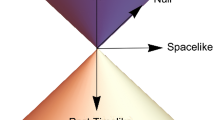Abstract
Abstraction turns equivalence into identity, but there are two ways to do it. Given the equivalence relation of parallelness on lines, the #1 way to turn equivalence into identity by abstraction is to consider equivalence classes of parallel lines. The #2 way is to consider the abstract notion of the direction of parallel lines. This paper developments simple mathematical models of both types of abstraction and shows, for instance, how finite probability theory can be interpreted using #2 abstracts as “superposition events” in addition to the ordinary events. The goal is to use the second notion of abstraction to shed some light on the notion of an indefinite superposition in quantum mechanics.
Similar content being viewed by others
References
Auletta, G., Fortunato, M., & Parisi, G. (2009). Quantum mechanics. Cambridge: Cambridge University Press.
Baues, H.-J. (1995). Homotopy types. In James, I.M. (Ed.) Handbook of algebraic topology (pp. 1–72). Amsterdam: Elsevier Science.
Cohen-Tannoudji, C., Diu, B., & Laloë, F. (2005). Quantum mechanics Vol. 1 and 2. New York: Wiley.
Ellerman, D. (2010). The logic of partitions: introduction to the dual of the logic of subsets. Review of Symbolic Logic, 3(2 June), 287–350.
Ellerman, D. (2017). Quantum mechanics over sets: a pedagogical model with non-commutative finite probability theory as its quantum probability calculus. Synthese, 194 (12), 4863–96.
Ellerman, D. (2017). Logical information theory: new foundations for information theory. Logic Journal of the IGPL, 25(5 Oct.), 806–35.
Ellerman, D. (2018). Logical entropy: introduction to classical and quantum logical information theory. Entropy, 20(9), Article ID 679. https://doi.org/10.3390/e20090679.
Feller, W. (1968). An introduction to probability theory and its applications, 3rd edn. Vol. 1. New York: Wiley.
Frege, G. (1997) In Beaney, M. (Ed.), The Frege reader. Oxford: Blackwell.
Nielsen, M., & Chuang, I. (2000). Quantum computation and quantum information. Cambridge: Cambridge University Press.
Shapiro, S. (2011). The company kept by cut-abstraction (and it relatives). Philosophia Mathematica (III), 19, 107–38.
Shimony, A. (1988). The reality of the quantum world. Scientific American, 258(1), 46–53.
Shimony, A. (1999). Philosophical and experimental perspectives on quantum physics. in philosophical and experimental perspectives on quantum physics: vienna circle institute yearbook 7. Dordrecht: Springer Science+Business Media, pp 1–18.
Tutte, W.T. (1984). Graph theory. Menlo Park: Addison-Wesley.
Univalent Foundations Program. (2013). Homotopy type theory: univalent foundations of mathematics. Princeton: Institute for Advanced Studies.
Vlastos, G. (1981). Platonic studies. Princeton: Princeton University Press.
Whitehead, A.N. (1978). Process and reality. New York: The Free Press.
Leitgeb, H., & Ladyman, J. (2008). Criteria of Identity and Structuralist Ontology. Philosophia Mathematica, III(16), 388–96.
Author information
Authors and Affiliations
Corresponding author
Additional information
Publisher’s Note
Springer Nature remains neutral with regard to jurisdictional claims in published maps and institutional affiliations.
Rights and permissions
About this article
Cite this article
Ellerman, D. On Abstraction in Mathematics and Indefiniteness in Quantum Mechanics. J Philos Logic 50, 813–835 (2021). https://doi.org/10.1007/s10992-020-09586-1
Received:
Accepted:
Published:
Issue Date:
DOI: https://doi.org/10.1007/s10992-020-09586-1




